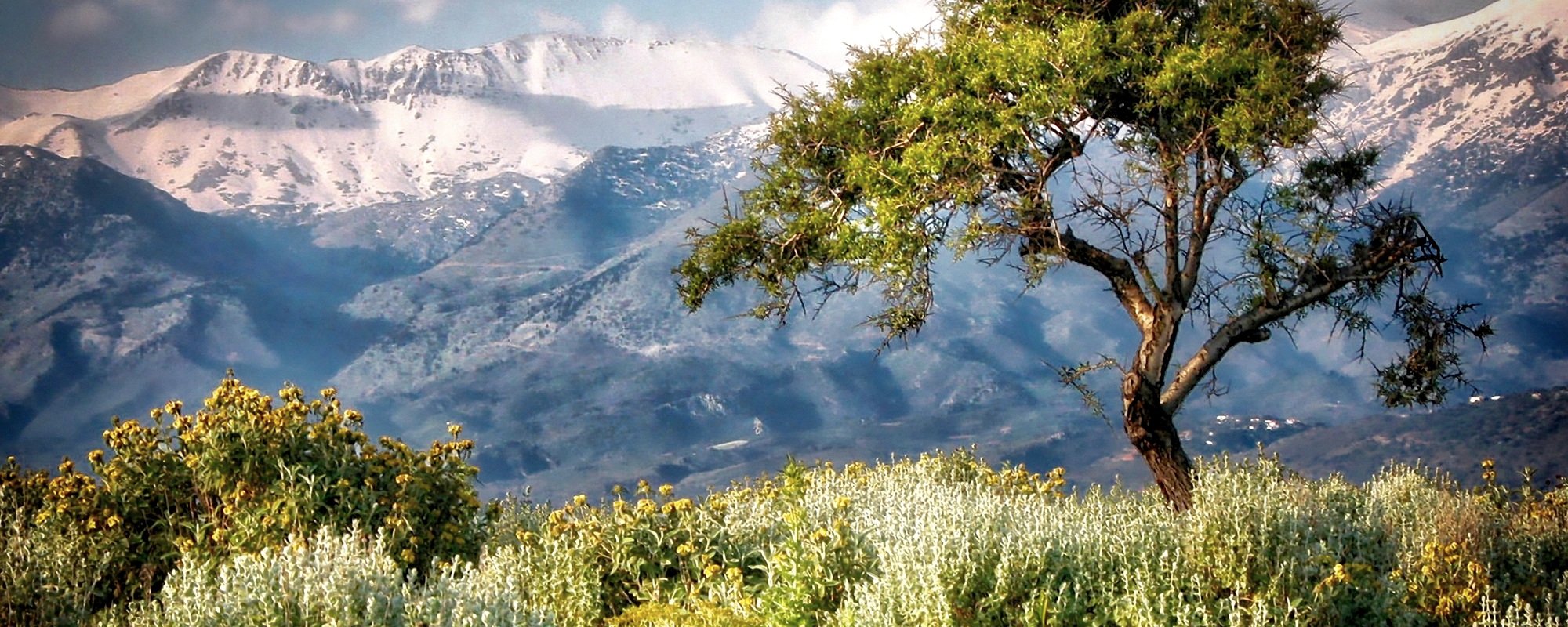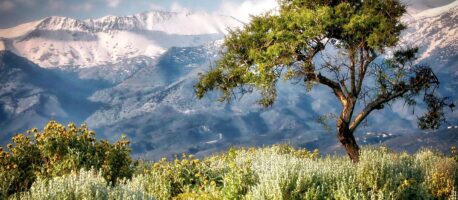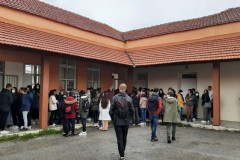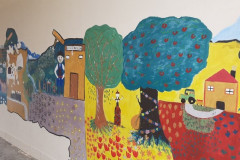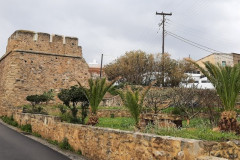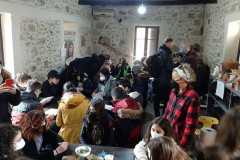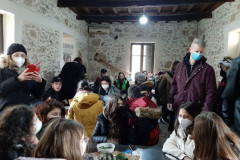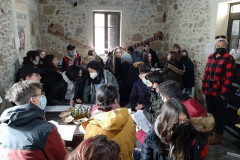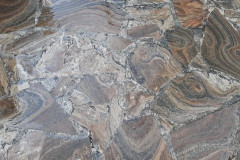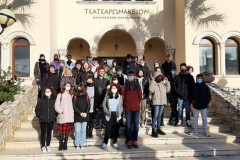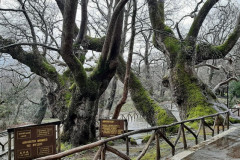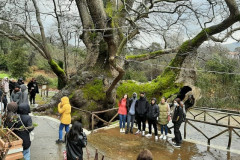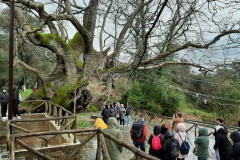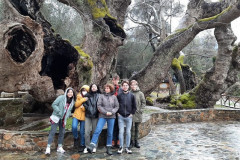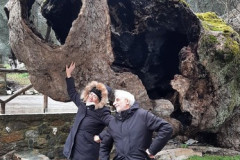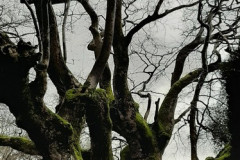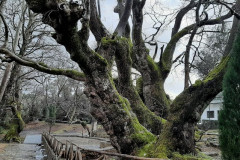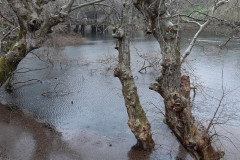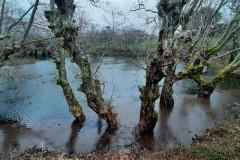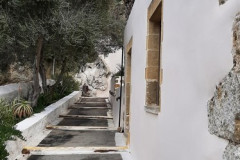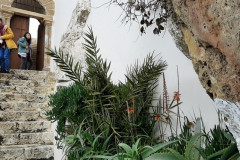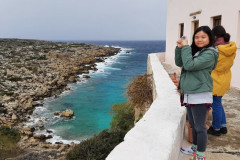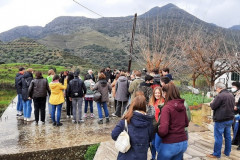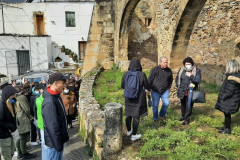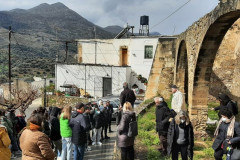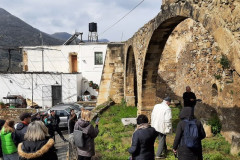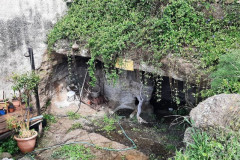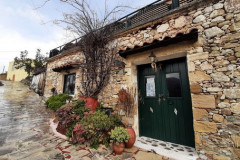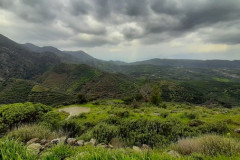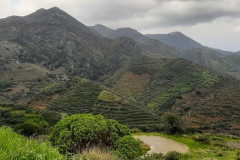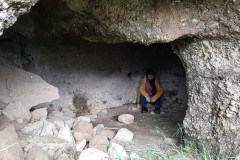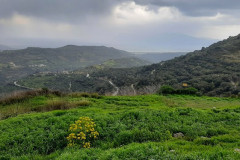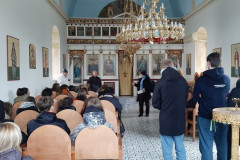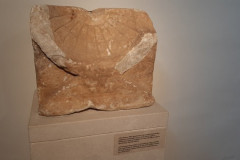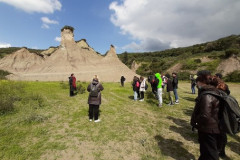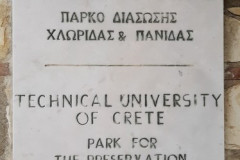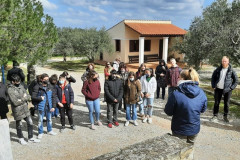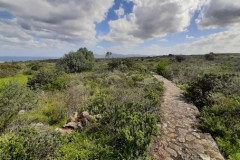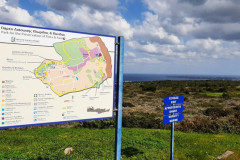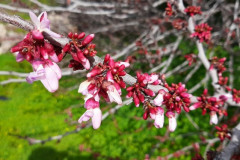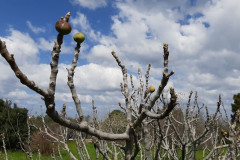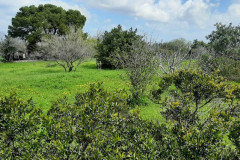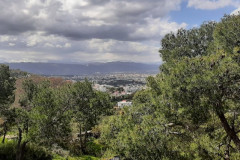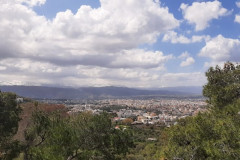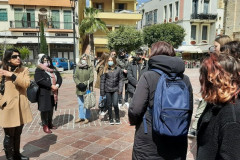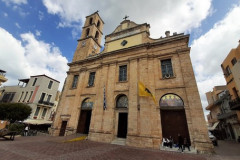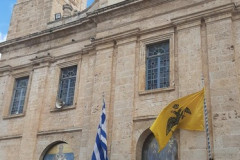Biodiversity meets music – first meeting of the project partners in Kissamos (Crete, Greece)
We have worked for a long time and longed even longer for the Erasmus+ project “Biodiversity meets music” to finally enable the direct exchange of students and teachers in the project. Therefore, we are very relieved that now with the trips to Kissamos (Crete) and Seville (Andalusia) the first exchange trips can take place, even though the effects of the Covid pandemic, the war in Eastern Europe and the rising cost of energy and living costs keep presenting us with tasks that often seem insurmountable, given the value that such trips represent, but are nevertheless tackled and mastered with incredible verve and perseverance by all those involved in the implementation of the project.
And so, on 20.03.2022, after 1½ years without the opportunity to travel, it could finally get underway. From various regions of Europe (Spain, Latvia, Norway, Italy and Germany), groups of mostly two teachers and about five pupils set out to visit our partners in Kissamos (Crete). Some groups already met at Athens airport, from where they spent the last hour flying to Chania on the same plane. Late in the evening, the driver of a minibus took us to the only hotel in Kissamos that was open at this early time of the year. Glad to have survived the journey without any major difficulties, we checked into our rooms and suspected that the weather would probably not correspond to the usual expectations of Crete – even in March. The palm tree and the fir tree (Araucaria heterophylla) by the pool rustled violently in the wind, and rain whipped against the veranda doors.
Day 1 – 21/03/22
The next morning, we met with the groups from the partner schools. The teachers, some of whom already knew each other from numerous previous virtual meetings, sat down directly together and discussed their journey, while the students mostly sat separately at their tables and enjoyed the rich and delicious breakfast buffet, some of them still a little tired. Everyone had their preferences, be it the vital coffee, the freshly squeezed orange juice or the delicious Cretan pastries.
Shortly before 9.00 a.m. we were welcomed by A. Kouroupi, the coordinator of the project at the school in Kissamos, and accompanied to the school. There we were warmly welcomed by all the students, teachers and headmaster. The Erasmus students from Kissamos welcomed us with traditional songs and dances.
After a snack, we accompanied the students to a workshop in the Archaeolab, where the students got an introduction to the herbal world of Crete and made an aloe vera cream, while the teachers, who unfortunately could not participate due to lack of space, enjoyed a coffee and exchanged ideas in a kafenion. For lunch with pizza and sandwiches, both groups met again in a restaurant on the beach.
After a short lunch break, the group gathered again in a classroom of the school and was taken live to the CRETAquarium Thalassokosmos of Heraklion, 175 km away, where a staff member guided us through the aquarium with his laptop and presented the species-rich micro-ecosystems of the Mediterranean Sea with their numerous living creatures and interconnections, but also addressed human intervention in these ecosystems and nature conservation.
Afterwards, we met for a first group photo in front of the Tsatsaronakeio Cultural Centre of the city, taking advantage of the few moments of sunshine of the day. In the cultural centre, students and music teachers performed traditional Greek musical instruments such as the lute, the violin or the Cretan mandolin. It was very interesting that the students do not learn the instrument by notes, but by ear and feeling. After so many new experiences, we ended the day with a communal dinner in a local restaurant. With a presentation, various Greek – pardon, Cretan – melodies, rhythms and dances as well as performers were introduced.
Day 2 – 22/03/22
Actually, on almost all days we heard excuses from all sides about the bad weather that would be on Crete just this week. In fact, the temperatures were not in the double digits even during the day. In addition, a gusty, sometimes stormy wind blew and drove rain in our faces from time to time. There were also some thunderstorms, especially at night. In this respect, one could understand the Greeks’ concern that the excursion to Elafonissi in the south of the island planned for today could literally “fall through”. But since we had already studied the weather forecast the week before, we were prepared for it. And it turned out to be a very nice excursion by bus, which took us over mountain roads through the Tiflos Gorge between Topolia and Koutsamatados to the beach of Elafonissis, famous for its pink sand. But one thing after the other: First we drove through the hinterland of Kissamos, past extensive olive groves further and further into the Cretan slate mountains. At a more than 1000-year-old plane tree (Platanus orientalis) with a diameter of more than 10 m in the hamlet of Vlatos, which has been declared a natural monument, we made a short stop to marvel at the mighty crown and the twisted and contorted branches that branch out just above the surface. Further south, the maquis dominated with its typical cushion-shaped shrubs.
We made another stop at the 17th century Greek Orthodox monastery Panagia Chrissoskalitissa. The weather was merciful to us, so we were able to visit the monastery during a break in the rain. There are several legends surrounding the monastery. The name Chrysoskalitissa (carved on gold) supposedly comes from the fact that one of the almost 100 steps leading to the monastery was made of gold. However, this step is said to have been sold by the patriarchate to the Turks to pay the taxes. Another legend, which can be read on a sign at the entrance to the monastery, says that at Easter 1824 Ottoman soldiers wanted to loot and destroy the monastery. On their way up the steps, however, they are said to have been attacked by a swarm of bees, so that they had to abandon their plan.
Special plants that lined our path were caper bushes (Capparis spinosa), the monodemic Cretan marsh bellflower (Petromarula pinnata) and the yellow scorpion violet (Viola scorpiuroides), which flowers from January to March. The surroundings of the monastery are characterised by phrygana (also called garrigue in the western Mediterranean): woody plants up to one metre high, which, in contrast to the maquis, would never grow tree-like even without growth hindrance (wind shearing, grazing by sheep and goats). Besides the tree spurge (Euphorbia dendroides), the asphodel (Asphodelus aestivus or A. microcarpus), a lily plant, is also typical. For the ancient Greeks, it was the typical plant of the underworld, which Homer even refers to as the asphodel meadow in his Odyssey. The starchy root tuber was given to the deceased to take with them into the afterlife. Later, in times of need, the roots were eaten as porridge together with figs.
A few kilometres further south lies a dreamlike, but unfortunately also increasingly touristically developed lagoon, which a few years ago was still considered an insider tip – the bay of Elafonissi, with an extensive sandy beach lined by extensive stands of tamarisk (Tamarix articulata), which offer protection from wind and sun and tolerate high salt levels in alkaline soil. You can wade across a waterway about 150 m wide to the small island of Elafonisi. Typical plant species here are the rosette-like dwarf bellflower (Centaurea bella), the sea fennel (Crithmum maritimum), the salt plantain (Limbarda crithmoides) and the thorny caper shrub (Capparis spinosa).
The special feature of this beach, however, lies in something else: Due to tiny, partly broken limestone skeletons of foraminifera, the sand shimmers pink in many places, especially when it is wet – a phenomenon that can only be observed on a few beaches worldwide. Foraminifera (chamberlings) refer to a very species-rich group of single-celled organisms (Rhizaria, approx. 12000 species) that usually carry a porous shell made of lime and whose shells, when washed up on the beach, are crushed and pulverised, giving the beach its sometimes strongly pronounced pink colour. There is scientific evidence that “environmentally friendly” sunscreens in particular are very harmful to the foraminifera or the diatoms with which they live in symbiosis – suspected here are metal nanoparticles such as titanium dioxide or zinc oxide, which have already been classified as harmful in other contexts. Due to the large occurrence of foraminifera worldwide and their uptake of phytoplankton, it can be assumed that they make a significant contribution to the global marine carbon and nitrogen cycle, so that an impairment of this group of organisms can be described as relevant to climate change.
After we had caught a rain break again at the beach of Elafonissi and could even enjoy some sunny moments, it was time for a refreshment of the physical well-being. On the way back, some students from Italy and Germany found a small sensation buried in the sand, the discovery of which was recorded on film: Evidence of recent dinosaurs was found, as a still slightly decomposed specimen of a baby dinosaur was dug up just below the surface of the sand. Amazingly, the skin was bright yellow and the animal – plastic!
Finally, we were able to have baguettes and hot drinks in a kafenion. On the way back through the Tiflos Gorge, we stopped to climb up to the Agia Sofia stalactite cave above the road. An easily accessible staircase made of natural stone leads up an estimated 200 steps to an open cave, about 20 m high and about 100 m wide, from which one can enjoy a fantastic view into the gorge. On the side of the rock face is the church of Agia Sofia, but the eye is drawn by the impressive stalagtite formations. As the limestone rocks in the back, dark part of the cave were wet and slippery, the tour was a little difficult for many of us – at least the torches of the smartphones could illuminate the way a little. The cave ceiling is populated by a few pigeons, which fluttered around in fright every now and then and had to look for a new resting place. The typical vegetation of the rock crevices on the steep slopes in the gorge includes the silvery-white knapweed (Centaurea argentea), the white-flowered spherical axe vetch (Securigera globosa), the false spruce thistle (Ptilostemon chamaepeuce) and the Cretan ebony bush (Ebenus cretica), an endemic butterfly bush that “turns the slopes pink” here in May.
That evening we finally visited a typical Cretan restaurant near the old harbour of Kissamos – Stimadoris. Over good food (meat and sea food) and in a good mood, students and teachers got into conversation. At the final raki with the host, however, the number of activists quickly became much smaller. It seems that it is not everyone’s drink.
Day 3 – 23/03/22
On the plan for the day were extensive hikes or walks with nature observations in the surroundings of Kissamos. In view of the weather, however, we fortunately had a bus available to take us into the hinterland of Kissamos to Polyrrhenia. On the way and on site, K. Chartzoulakis, the former director of the Institute for Olive Tree and Subtropical Plants in Chania told us some interesting facts about the olive groves.
told us some interesting facts about olive oil production in West Crete. Asked about the death of olive trees (olea europaea) in Apulia and other oil-growing areas in Europe caused by the “killer” bacterium Xylella fastidiosa and the clear-cutting as a protective measure, he expressed great concern: “We are doing everything we can to prevent the bacteria from spreading to Crete. Fortunately, we have succeeded so far. However, there is currently no known subspecies or cultivar that would be resistant to Xylella.” Xylella multiplies rapidly in the conduits of the trees, preventing the transport of water in the wood, so that the trees slowly die. To prevent the spread, the infected trees must always be cleared as soon as possible.
On arrival in Polyrrhenia, Roberto tried to get the whole group to do a sun dance. Shortly afterwards, the sun also shone for a few minutes. However, during the first attempt to explore the old town, it poured with rain, so we sought and found refuge in the bus. When asked if he might not have made a mistake in his summoning ritual, he pretended to be quite innocent, but we granted him a second chance. On the second attempt, however, we caught a somewhat larger rain hole and explored the remains of the ancient acropolis perched on top of a hill, while the flanks of the hill have numerous dilapidated structures of old houses, wells and gravesites, which also offered us shelter during intermittent rain showers and hailstorms, some of which were heavy. The importance of the town, which covers about 30 hectares, for western Crete is not only revealed by the remains of the mighty town wall with defence towers, but also by its central location in relation to the harbours in Kissamos and Falasarna. In the “Church of the 99 Holy Fathers”, which we visited twice because of the heavy rain, there are various inscriptions from the city. Stones from the ruins of the old Polyrrhenia were also used to build the church. Also interesting was the tale of how, after threshing, the chaff was separated from the grain by taking advantage of the wind, which was sparse for everyone. Despite the modest weather, one could still catch a great view of the bay of Kissamos.
The bus then took us back to Kissamos, where we visited the Archaeological Museum of Kissamos. Many people know Knossos as the most famous temple complex of Minoan architecture. Kissamos was built on a similar ancient Minoan city, so today the “old city” is hidden under Kissamos – just as in Chania. So when a new building project is undertaken, archaeologists first move in to examine the subsoil for valuable archaeological structures – which can sometimes mean stopping or even banning construction. Under Roman rule, the city attained a certain independence in the 3rd century AD, which manifests itself in some finds that are not to be found everywhere, e.g. remains of a theatre, a bathing complex, a cistern and remains of an aqueduct. In the 12th century Kissamos was occupied by the Genoese, later by the Venetians, who also fortified the city, for which they recycled, so to speak, the material previously used. The fort, which also gave the town the name Kastelli in the meantime, fell to the Turks in 1645 and has been fought over by Turks and Cretans ever since.
After the museum visit, we got into the waiting minibuses to visit some of the sights around Kissamos again. Unfortunately, the Norwegians could not be found, so we had to start the trip without them. First we visited the Komolithi sand hills, bizarre clay formations located on the road connecting Kissamos and Paleochora, which reminded us a little of Cappadocia in central Anatolia (Turkey). This area has developed into a huge sand pit due to the uplift of West Crete from the seabed and it was imagined that sharks could have been encountered here long ago. The sunny sections were used for group photos, but as it had rained again before, the sandy soil was rather loamy-muddy and turned the shoes into heavy concrete blocks in no time – especially the white sneakers. A little later, the group was seen scratching in the grass at the side of the road before they were allowed back on the bus. In any case, it was fun, which could still be observed the next morning on the marble staircase in the hotel.
After a short detour to an old Venetian bridge over the river (potamos) Rema and past some really lavishly modernised farms in the area by foreign buyers, we were invited by the municipality council of Kissamos to a rich and delicious lunch at H XARA Cafe & Tavern. In a small address, the Mayor highlighted the importance to promote this kind of exchange between schools to get familiar with other cultures and increase the understanding between different nations. We would like to take this opportunity to thank you once again for the invitation and appreciate the hospitality very much, and yes – we enjoyed our stay in Kissamos with all the new friends.
Back at the hotel, most of us were able to rest and recover a little. However, the coordinators of the partner schools still met in the lobby of the hotel to discuss details of the further upcoming trips to Seville and Stolberg and to narrow down the time slots for the trips in the coming school year.
In the evening, everyone met in the town hall for an exchange and mutual presentation of the schools, the regions and the activities in the project so far, with other teachers and the headmaster of 1st Junior High School Kissamos also joining in. The town hall provided a stage which some groups used for their presentations. The group from Latvia started with a presentation of their town and school. The excitement increased when the audience was called on to take a Kahoot quiz on the facts presented. In another presentation, important animal and plant species of the different habitats around Jelgava were introduced. As the next group, our delegation from Stolberg presented the school, our musical activities, the city, the habitats with their characteristic leading species and a little bit of the culture in the surrounding area. Afterwards, Aachener Printen were distributed for tasting.
The group from Monopoli first gave us a virtual tour of their school, then presented typical Italian dances such as the Tarantella, before performing a dance themselves – in dance costume. Finally, the pupils from Trondheim also presented their school and performed two dances: The Halling, a male dance with athletic elements to impress the girls, especially by knocking away a presented hat while jumping with the foot. The girls of the group returned the favour with an Aattetur, a circle dance in ¾ time.
Finally, the group from Kissamos danced to the sounds of the lute and violin. Afterwards, all the guests were invited to join in the dancing, which led to some commotion on the stage, but all the willing dancers found enough space. Quasi as an encore, Roberto did not miss the opportunity to dance a Sirtaki together with the Greek students – with a passion that astonished many.
And so it was that they were fortified with home-baked, typically Greek pastries, which the teachers, their family members and presumably other relatives working in the background had conjured up in abundance. However, the students of all nations soon found themselves on the stage again to try out modern dance forms together, which were set by a computer animation and which everyone dutifully imitated and – had fun doing!
Day 4 – 24/03/22
After breakfast we left for Chania to visit the Flora and Fauna Park of the Technical University of Crete. A. Zacharouli (Agriculturist), guided us through the park, which was inaugurated in 2004 and is allowed to develop without human intervention: “Let nature be nature”. At a time when biodiversity loss is reaching alarming proportions, mainly due to habitat destruction, the 30-hectare park is a small but important area where native plants and animals are protected. In the past, the area was used for grazing and agriculture, an activity that continued long after the acquisition of the land by the Technical University of Crete. In 1994, the land was fenced off and access for hunters, shepherds and plant collectors was prohibited. Since then, the area has been protected as a nature reserve. Currently, only the olive grove is managed organically by the park staff. The park’s participation in the Reveil Festival with the presentation of the Flora and Fauna Preservation Park Soundscape was particularly interesting. The arts cooperative Soundcamp organised the online festival in early May 2021, a collective production of streamers at listening stations around the planet. The broadcast began on the morning of Saturday 1 May in South London near the Greenwich Meridian, tracking the sunrise in the west from microphone to microphone, following the wave of amplified sound that orbits the Earth every 24 hours at first light. Reveil transmitted the sounds from live open microphones operated by streamers on the Locus Sonus soundmap, the Cyberforest programme, the LIDO deep-sea hydrophone observatory, the BIOM Open Microphone Network and other locations. These ranged from formal research to private projects and one-off broadcasts. The sounds provided were mixed live. The streaming of the park soundscape will be used permanently for further study and to support a range of educational activities on acoustic values and biodiversity.
After a break with a picnic in the park, we set off for Chania, first to take a look at the city and the white mountains from outside the Venizelos Tombs hills. Although the history of the place was a little lacking, we enjoyed the longer sunny stretches and the view of the city. The place was perfect for a group photo.
Unfortunately, the planned workshop of building traditional musical instruments with natural materials had to be cancelled because the instructor was ill. So we set off to explore Chania. The market hall in Chania, where you could have enjoyed the diverse cultural and culinary specialities in one place and with all your senses, has been closed for several years because the building needs to be renovated.
E. Kournidaki, a French teacher of the school took us on a guided tour of the city, starting at the Orthodox Cathedral, a three-nave basilica with a bell tower on the façade, of Chania built in 1860 on the site of an earlier church dedicated to the Virgin Mary. From there we strolled through the winding streets of the picturesque Topanas (Cannon Court) district with Venetian and Turkish buildings within the city walls from Venetian times, briefly visited the Etz Hayyim Synagogue (Tree of Life) with its two courtyards, which is in use again today, and reached the port at the Naval Museum. Here we were divided into beef, vegetarian and chicken groups according to our preferences for lunch. Even though the sea was still quite choppy and the harbour breakwater could not really calm it down, we enjoyed the comparatively high temperatures on our harbour promenade and especially the warming rays of the sun on the first day on which we had no rain. Past the Venetian arsenals, stone halls with massive barrel vaults to our restaurant at the beginning of the breakwater.
After a sumptuous meal, as always, we strolled back to the former mosque and enjoyed a coffee or two in the afternoon sun or explored the city again on our own. For the students, shopping was the order of the day – souvenirs from the trip also had to be bought. And so the time flew by until we all met again at the square in front of the church to walk together to the bus.
Back at the hotel, we were showered with gifts and souvenirs from the community and the teachers, which we were very happy about. Afterwards, the students met each other, while the teachers went out for a small dinner in the town, as many were still full from lunch in Chania. As the Norwegians and we had to leave for the airport by minibus at 4.45 am the next morning, we did not savour this last evening to the last second. However, we said goodbye to each other with the feeling that we had made new friends and with the prospect of meeting again soon in Seville, later in Stolberg or in the next school year in other European places.
We would like to thank our hosts for the numerous impressions of this trip, many of which certainly have to be processed first, who took care of us almost around the clock, e.g. to retrieve a forgotten handbag, to prepare and keep ready the delicious appetisers, to defy imponderables such as capricious weather conditions, to replace participants who fell ill and were therefore absent, and to have put together a balanced and very attractive programme for all of us despite all adversities. A big thank you also to all those who supported the project in the background. And above all, a very warm thank you for the incredible hospitality, which was always palpable and is by no means a matter of course. We felt very much at home and hope to be able to give something back from this spirit of friendship that developed during this long-awaited first week of getting to know each other.
René Ostrowski
Project Coordinator Stolberg
Presentations and Links
